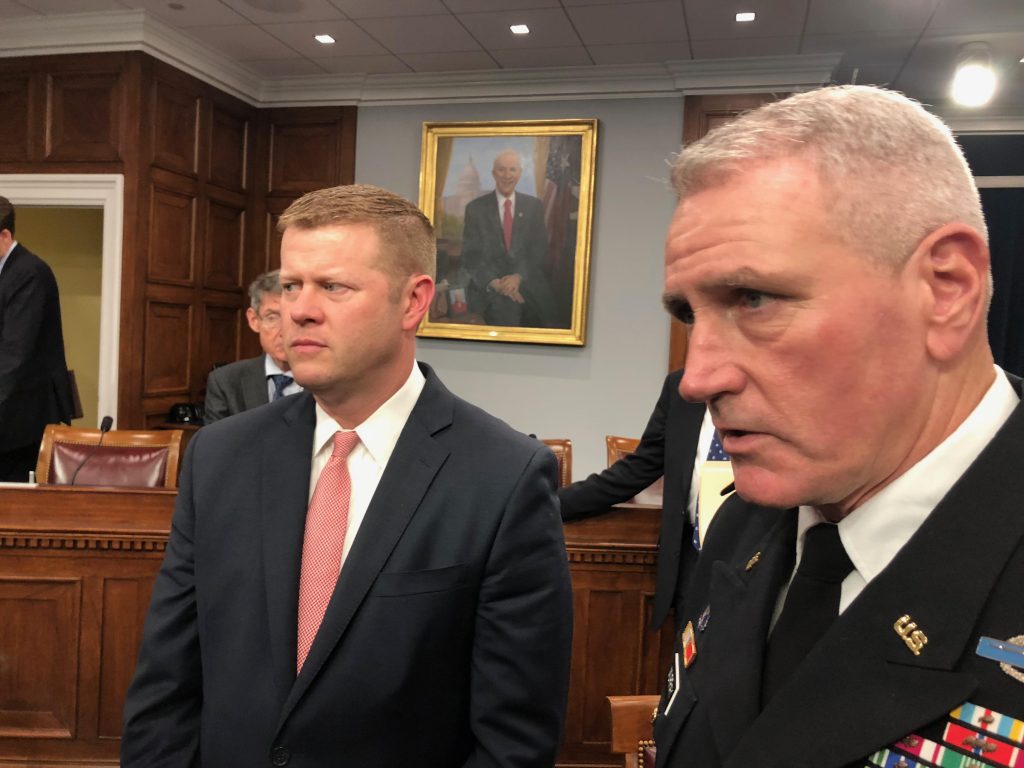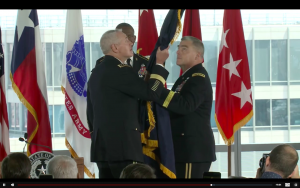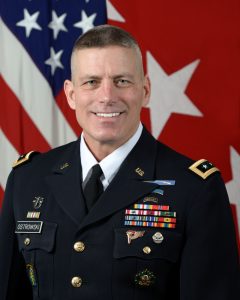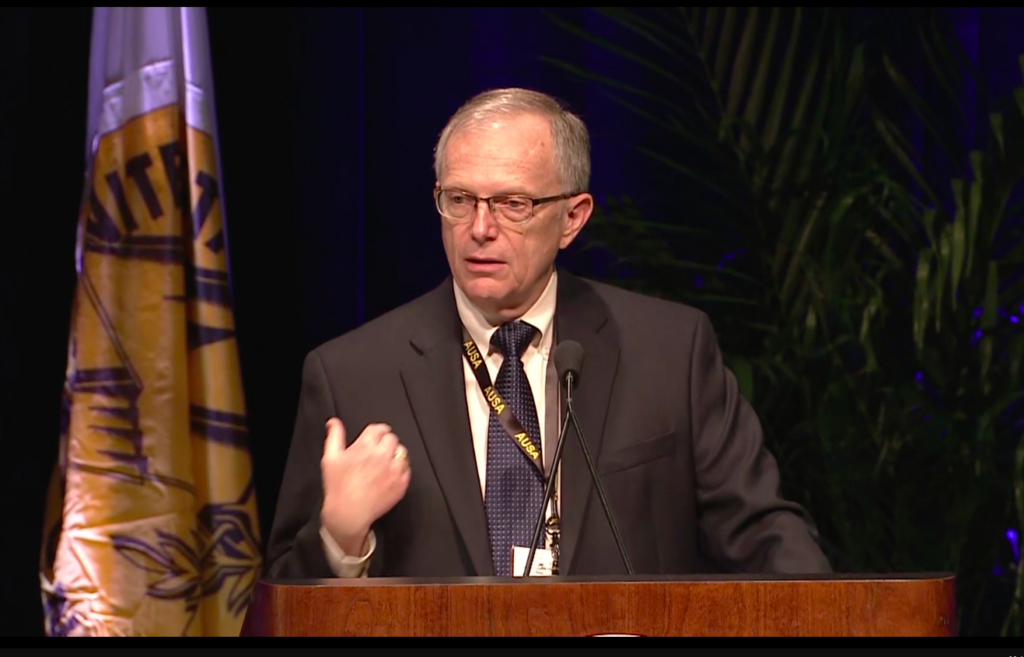CAPITOL HILL: The newly created Army Futures Command will not interfere with civilian oversight of the service’s notoriously troubled acquisition systems, AFC’s commander and the Army’s No. 2 civilian assured the House Armed Services Committee today.
The gently skeptical tone was set by the title of the HASC readiness subcommittee hearing, “Army Futures Command: Will It Help?” Chairman Joe Wilson and ranking Democrat Madeleine Bordallo reinforced the theme with opening statements and pointed questions asking if the new command, created to unify a fragmented and dysfunctional Army acquisition system, would only add more layers of bureaucracy. But several of their subcommittee colleagues proudly proclaimed their support of the reorganization. By the end, Wilson and Bordallo themselves seemed mollified by the answers they got from Undersecretary Ryan McCarthy and newly promoted four-star Gen. John “Mike” Murray.

Army Undersecretary Ryan McCarthy and Gen. John Murray take tough questions from reporters after the HASC hearing.
Two Bosses Or One?
The crucial issue? AFC is supposed to bring together experts and authorities currently scattered across the Army – combat vets and scientists, concept developers and field testers, requirements writers and acquisition officials – to develop new tactics and technologies much faster. But by law the Army’s acquisition Program Executive Officers (PEOs) and Project Managers (PMs) report to the civilian, Senate-confirmed Service Acquisition Executive (SAE). That’s Dr. Bruce Jette, also known as the Assistant Secretary of the Army for Acquisition, Logistics, & Technology (ASAALT).
That’s a statutory arrangement the Army cannot change. But in the reorganization, the service has dual-hatted Jette’s military deputy, Lt. Gen. Paul Ostrowski, to be Murray’s deputy as well. Our Defense News colleague Jen Judson, recently summed this up as “Military deputy to US Army acquisition now has two bosses.” While Murray and McCarthy didn’t cite the article, they spent a lot of time today refuting that idea behind that headline.
Ostrowski is “somebody I can interface with almost as a peer day to day,” Gen. Murray told reporters after the hearing (emphasis ours). “It’s not that he reports to me every day or I’m providing him guidance every day.
“It’s more of a direct link into the acquisition community,” Murray elaborated. “I have somebody I can pick up the phone and talk to.”
Ostrowski will be “matrixed” into Futures Command, “informally a part of my organization,” in Murray’s words (again, emphasis ours). But Ostrowski will still be taking his orders from Jette, the Senate-confirmed civilian.
Ostrowski’s relationship with the AFC commander will be very different, Murray said. “I will call him and say, hey listen, we’re having a problem with this program, the acquisition strategy doesn’t seem to be synched up right, let’s work together and let’s fix this,” Murray told reporters. “If Paul and I can’t agree, I’ll go to Dr. Jette; and if Dr. Jette and I can’t agree, there’s an ultimate arbitrator called the Secretary of the Army.”
Flexible Relationships
By contrast to the acquisition system, Murray’s relationships with other parts of the Army will be fairly straightforward. While the service is standing up a new headquarters in Austin, it’s just 50 people – mostly civilians – working with bare walls and minimal future, Murray said, and he plans to keep the final size well under the official cap of 500. The vast majority of Army Futures Command will consist of existing Army personnel and organizations that will stay physically where they are today but start reporting to the new boss in Austin.
- By the end of December, the Army’s Training & Doctrine Command (TRADOC) will give Murray much of its Army Capabilities Integration Center (ARCIC), specifically the parts that focus on future threats, technologies and concepts. (To get technical, concepts and requirements developers will move to AFC, while capabilities managers will stay in TRADOC; Murray admits it’ll take a lot of work to keep these different elements working together across the commands). TRADOC will continue to develop the doctrine that governs current Army training, exercises and professional military education. “There’s no law defining when a concept can go from a concept into doctrine,” Murray said, so he and TRADOC commander Gen. Steve Townsend have a lot of leeway to work out the handoff.
- By the end of April, Army Materiel Command (AMC) will give Murray its laboratory system, composed of the Army Research Laboratory (ARL) and the far-flung Research, Development, & Engineering Command (RDECOM). That will allow AMC to focus entirely on sustaining, maintaining, and supplying the equipment that’s already in service today. Futures Command will focus on finding new technologies for the future and experimenting with them.
- Forces Command (FORSCOM), will provide combat troops to conduct the field experiments and, ultimately, to use the new equipment.
- The new technologies themselves will spring either from the Army’s own labs (ARL and RDECOM) or from the private sector. In fact, the main reason Army Futures Command will be headquartered in Austin is to tap into local entrepreneurs and academics, and Murray will have a subunit, the Army Application Lab, in an Austin incubator called the Capital Factory.
- Helping bring all these pieces together will be the eight Cross Functional Teams created last fall; while they existed before Futures Command, they’re already reporting to it, Murray told the subcommittee. Each of the CFTs focuses on one of the Army’s Big Six modernization priorities – in order, long-range firepower, armored vehicles, aviation, command networks, air & missile defense, and soldier equipment – or a cross-cutting support function – either augmented reality training or Precision Navigation & Timing (PNT) without GPS. Small, streamlined organizations with less than a dozen permanent staff apiece (so far), the CFTs borrow additional personnel as needed from across the Army to ensure that every organization working in an area has a representative in the room to work out problems fast.
All the relationships above can be fairly flexible, adjusted as Murray and other Army leaders see best. But it’s the law that governs the crucial bridge between experimental prototypes – which definitely belong to Futures Command – and actual systems in service – maintained by AMC and used by FORSCOM. It’s the Army’s acquisition officials, its Program Executive Officers and Project Mangers, who actually have to develop and field new equipment. And, in both the Army’s old structure and the reorganized one, the PMs report to the PEOs, who report to Ostrowski, who reports to Jette. Their relationship to Army Futures Command will be complex and restricted by statute.
“Oversight, Not Authority”
To streamline the system while still complying with the law, Murray and his Futures Command will have legal authority over the initial phases of the acquisition process, namely developing formal requirements and experimenting with prototypes. But when the Army decides to move from experimentation to actually developing a weapons system – what’s known as the Materiel Development Decision – then Murray will hand over control to Jette.
Murray will have “oversight, not authority” over the acquisition programs, he told the subcommittee. “We’re building systems right now” to execute that oversight, he said, without providing details.
But while Murray can monitor the acquisition programs, only Jette can give them marching orders. “His role has not changed since the day he was sworn in to today,” Murray explained. “He remains solely responsible to the Secretary of the Army for acquisition, logistics, and technology.”
Let’s get technical for a moment (the faint of heart should skip this paragraph). By law, it’s Jette, as Service Acquisition Executive, who now and in the future possesses Milestone Decision Auhtority :
- Milestone A, commencing Technology Maturation & Risk Reduction (TD);
- Milestone B, for Engineering & Manufacturing Development (EMD); and
- Milestone C, Production & Deployment.
By law, Jette must also get the service’s uniformed chief, Gen. Mark Milley, to concur with Milestone A and B decisions. Army leaders added today that Jette would in practice always get Milley’s concurrence for Milestone C as well.

Gen. Mark Murray (left) formally receives the colors of the newly created Army Futures Command from the Chief of Staff, Gen. Mark Milley (left)
Under this structure, chairman Wilson asked at the hearing, are you worried that Army Futures Command won’t have the authorities it needs to fix acquisition? Conversely, Wilson continued, “are you concerned that the Secretary of the Army and the Assistant Secretary will lose visibility of programs they remain accountable for?”
“No,” Undersecretary Ryan McCarthy replied.
There was a pause while the chairman waited for the rest of the answer and McCarthy realized he’d better give one.
“No, we’re not concerned,” he said.
Another pause.
“We appreciate the succinct response,” Rep. Wilson said to laughter. “The next question — I think you may have answered that too — are there any further legislative initiatives that are needed by anyone here to back up at your efforts?”
“Not at this juncture, sir,” McCarthy said.
In other words, the Army believes it has all the legal authorities it needs to reform. Now it just has to reform.
Move over FARA: General Atomics pitching new Gray Eagle version for armed scout mission
General Atomics will also showcase its Mojave demonstrator for the first time during the Army Aviation Association of America conference in Denver, a company spokesman said.





























